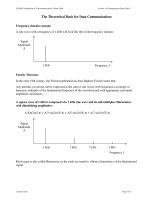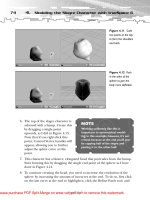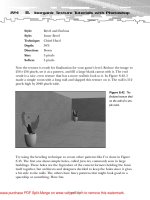Tài liệu Tips, Tools, and General Guidance for Public Speaking pptx
Bạn đang xem bản rút gọn của tài liệu. Xem và tải ngay bản đầy đủ của tài liệu tại đây (916.74 KB, 39 trang )
Lutheran World Relief
Speakers Bureau
Tips, Tools, and General Guidance for
Public Speaking
700 LIGHT STREET | BALTIMORE, MD 21230 | LWR.ORG | 1-800-LWR-LWR-2
TO OTHERS, THROUGH OTHERS.
Speaking from the Heart for LWR
Prepared for and in honor of the fabulous and hard working
members of LWR’s Speakers Bureau.
LWR: Tips, Tools, and General Guidance for Public Speaking, Page 2
Thank You!
On Behalf of the Lutheran World Relief Speakers Bureau, let me be the first to thank you
for taking the time to review these “Tips, Tools, and General Guidance for Public Speaking.”
As I’ve taught public speaking to countless college students, activists, church members,
CEOs and friends — one thing has remained constant—everyone, no matter how much or
how little experience they’ve had with public speaking, is usually looking for two things: 1)
the magic formula that will automatically and easily make them a public speaking star;
and/or 2) a tip or trick that will wipe out the nerves they feel each time they get ready to
speak in public.
Unfortunately, there is no “magic formula” for becoming a fabulous public speaker and
there certainly isn’t one tip or trick that can erase public speaking anxiety.
I can offer you a guaranteed, long-term formula for public speaking success that will help
you and LWR: preparation, practice, speaking from the heart, and getting out there to
speak as often as you can. In addition to the key—speaking from the heart—the only thing
that can make you a great public speaker is giving public speeches—again, and again, and
again. And, the great news is this: you can get tons of practice giving speeches because
there are literally hundreds, maybe thousands, of audiences out there ready and willing to
hear from you about LWR!
What you’ll find in the pages that follow are tidbits of public speaking and presentation wis-
dom that I’ve collected and found most useful over the years. Use these ideas and informa-
tion to inform your preparation, your practice and your delivery.
I am so thankful that there are people like you out there — people who are committed to
spreading the word about the great work that LWR does on your behalf around the world.
Thank you for your time, your energy and thank you for your role in ensuring that “each per-
son and every generation lives in justice, dignity, and peace.”
A thousand thanks to you,
Lisa Baumgartner Bonds
VP, External Relations
Lutheran World Relief
For more specific information and ideas on how to really take your public speaking ability to the next level,
take a look at the description of a “Public Speaking Journal” on page 33.
LWR: Tips, Tools, and General Guidance for Public Speaking, Page 3
A Prayer for Speakers:
Dear Gracious God, Let the words of my mouth and the meditation
of my heart be acceptable to you, because you are my mighty rock
and protector.
(Psalms 19:14, taken from the RSVP and CEV versions of the Holy Bible)
Lutheran World Relief’s Vision:
Empowered by God’s unconditional love in Jesus Christ, we envi-
sion a world in which each person and every generation lives in
justice, dignity and peace.
Lutheran World Relief’s Mission:
Lutheran World Relief works with partners in 35 countries to help
people grow food, improve health, strengthen communities, end
conflict, build livelihoods, and recover from disasters. With people
in the U.S., we work for justice for those we serve.
Lutheran World Relief’s Core Values:
•
Faith is active in love.
•
God gives all people dignity.
•
We serve with partners.
•
We make good use of God’s gifts.
•
We work for justice and peace.
LWR: Tips, Tools, and General Guidance for Public Speaking, Page 4
What does it mean to speak from the heart?
•
You speak because of a call , grounded in faith and mercy and grace;
•
You speak because it is a vocation, a way to live out your faith;
•
You speak because you know that your communication about the work LWR does, the
people LWR serves, and everything that makes up LWR’s vision is about more than
words.
•
When you speak about LWR, it’s not “just” communication, it’s communion.
•
To communicate about LWR, you go beyond basic dictionary definitions to use words
that are written on the human heart—words that help us to commune with people
around the world and with one another; words that help to develop trust, to build pas-
sion, to draw out compassion; words that engage our faith, words that draw people to-
gether to do good; words that encourage us to feel...to trust...to love. Words that help
us get to the truth.
The “basics” of communication — technical writing skills, grammar, spelling, photos, for-
mat, volume — are all necessary, but they are useless if your heart is in the wrong place
when you produce and speak them. Speaking without heart is like playing the piano without
feeling. You might be able to read music, play from memory, and put your fingers on the
right keys — but, if your heart isn’t in it, voices won’t start singing, feet won’t tap and spirits
will not be moved.
LWR: Tips, Tools, and General Guidance for Public Speaking, Page 5
Paul on Speaking from the Heart
Then Paul stood in the midst of the Areopagus and said, ‘Men of Athens, I perceive that in
all things you are very religious; for as I was passing through and considering the objects of
your worship, I even found an altar with this inscription: TO THE UNKNOWN GOD. Therefore,
the One whom you worship without knowing, Him I proclaim to you. Acts 17:22-23
In the four sermons that Luke records in the books of Acts, Peter, Stephen, and Paul all
practiced the Law of Connection, which says that you must touch a heart before you ask for
a hand. Paul’s sermon recorded in Acts 17 is a masterpiece. Paul connected brilliantly with
people from a different culture, showing he understood both Greek society and human
needs.
Notice how a master communicator connected with his audience. Here are Paul’s “rules”
for making connections:
•
He began with affirmation.
•
He bridged his subjects with the familiar.
•
He enlarged their vision of God.
•
He used inclusive language.
•
He gave them encouragement and hope.
•
He identified with some of their own poets.
•
He gave them specific action steps.
Only when Paul had built relational bridges did he issue a clear call to repent.
As people speaking on behalf of LWR, we can move from communication to communion,
from the basics to the art, from information to truth by following Paul’s teachings to speak
from the heart.
Enjoy your public speaking transformation and, thank you for putting your faith into action
with LWR.
LWR: Tips, Tools, and General Guidance for Public Speaking, Page 6
CHARACTERISTICS OF AN EFFECTIVE SPEECH
1. Speaker Commitment.
2. Well-defined/narrowed topic.
3. Clear sense of purpose.
4. Audience involvement.
5. Substantive development.
6. Structure and design.
7. Skillful language usage.
8. Effective presentation.
9. Ethical considerations.
LWR: Tips, Tools, and General Guidance for Public Speaking, Page 7
Message Outline Questions
What do you want as an end result? (Communication outcome)
With whom do you want to communicate? (Target audience)
What are the self-interests of your audience? (Needs/concerns/interests)
What do you want to say? (Message)
How will you say it? (Communication channel)
Who will you use to say it? (Spokesperson or spokespersons)
How can you package it (message) with the greatest odds for successful
action? (Raising an audience need/concern/interest and offering your
message as a solution)
LWR: Tips, Tools, and General Guidance for Public Speaking, Page 8
MESSAGE DEVELOPMENT
What is the ONE POINT we want to make to engage the public?
What is our over-arching message? You (the audience) should support/denounce/act on
_____________ because ______________.
Start where THEY (your audience) are, not where you are. You need to begin communicat-
ing with the same premise or “location” as your audience. The way to persuade people
is to listen first and listen as much as possible, then talk.
Who is your target? Remember: You can’t persuade everyone. (Consider levels of priority
for audiences.)
A GOOD MESSAGE IS:
=Clear
=Concise
=Connected - to where people are emotionally, to the things your target audience
cares about, to what is important to them and not important to us.
=Contrasting - why is this course of action better than the alternative? Make it con-
crete, not abstract.
=Credible - your audience must believe what you say in a way that is connected to
them.
=Consistent
In hostile situations or when someone wants to get you “off message” you need to know
your ABCs:
A
cknowledge
(their question)
Bridge
(build a bridge to your key message)
Connect
(highlight your key message)
LWR: Tips, Tools, and General Guidance for Public Speaking, Page 9
Oral vs. Written Language
“A speech is not merely an essay standing on its hind legs…”
In comparison with written language, oral language is or uses:
More words that refer to human beings and human relationships to help create sustain in-
terest and attention.
More personal pronouns such as “I,” “you,” “we,” and “our” to aid in connecting to the audi-
ence.
Shorter thought units, including sentence fragments and interjections to make speeches
easier to follow.
More repetition of words, phrases, and sentences to help embed the message in the minds
of listeners.
Shorter words, including more contractions to make the language sound more conversa-
tional.
More familiar words to increase identification and to make the message easier to under-
stand.
Less formal.
LWR: Tips, Tools, and General Guidance for Public Speaking, Page 10
Preparing, “Writing” a Great Speech
I don’t know what’s worse, preparing the speech or giving it. But what I do know is that
behind every great speech, is a great writer. The following steps will guide you to prepar-
ing and writing your own "great" speech.
1. Select a Topic - come up with several topics and choose the best one
2. Determine the Specific Purpose and Write a Thesis Statement - What is your
purpose? Is it to inform, describe, demonstrate, show, explain, give insight, edu-
cate, ease pain, or support a cause? Is it to persuade, convince, prove, petition,
change, stress, or motivate? Or is it to merely entertain and make someone
laugh? Do you have a power statement?
3. Analyze the Audience and the Occasion -
a. Audience: What do they know about the topic? What interest do they
have in the topic? What is their attitude towards your chosen topic?
b. Occasion - What is the reason for the deliverance of the speech?
4. Find the Material to be spoken - Is it something you already know about? Is it
something that you have to research? Do you need to interview anyone?
5. Organize the Speech -
a. Attention - you need to find an attention grabber
b. Goodwill - you want to leave the audience with a feeling of benevolence
c. Motivation - motivate to action
6. Word the Speech - Prepare an outline and then fill in the outline. Try to follow one
train of thought. DO NOT WRITE THE SPEECH OUT WORD FOR WORD. Use an out-
line that has phrases for each entry.
7. Practice the Delivery - Try to have the speech memorized in your head, but do not
speak as though it were memorized. You want to be able to sound as though you
are having a conversation with the audience.
8. Deliver the Speech - If you find that talking in front of people without props causes
you to hyperventilate, consider preparing props that reflect your speech.
LWR: Tips, Tools, and General Guidance for Public Speaking, Page 11
How to Prepare, Practice and Deliver a Great Speech
Tip 1- Write and rewrite the outline of your speech until it sounds exactly right to your own
ears. Don’t write the speech out word for word. Don't use words that are hard to pro-
nounce. Use everyday language so that your audience can understand your message
more easily. Avoid technical terms or keep them to a minimum whenever possible.
Tip 2- Remember to use descriptive phrases so your listeners can get a mental picture in
their minds of what you are talking about. People don't want to be told, they want to be
given a mental picture so they can better understand your words.
Tip 3- Avoid using a lot of statistics that will put your audience asleep in their seats. Keep
necessary statistics in your speech to a minimum amount.
Tip 4- Humor can be an effective way to amuse your audience, drive a point home, or sim-
ply help to keep their attention on you. Humor can also effectively lessen tension, espe-
cially yours. You can use short jokes or personal anecdotes for this purpose. Just make
sure your humorous material is appropriate for the audience you are speaking to. If you’re
unsure about your ability to use humor—don’t use it.
Tip 5- Your speech will probably either inform or persuade your listeners to take action in
order to help a group or cause. Be sure to include localized information in your speech
that pertains to your audience's specific needs.
Tip 6- Read your speech (from the phrase outline) out loud several times to hear how it
will sound to your audience. Practice giving your speech in front of a mirror. That way you
can see how you are going to look to the audience. Practice your speech in front of a
friend or family member. These techniques can help you relax and feel more comfortable.
Tip 7- Make sure to speak a little louder than normal conversation when you are giving
your speech. Avoid yelling into the microphone, but speak loud enough so that you can be
easily heard by the entire audience, not just the first few rows.
Tip 8- When you are giving your speech to your listeners, remember to slow your speech
down a little bit and don't rush through the words. Make sure to enunciate and don't slur
your words either.
Tip 9- Brochures, flyers, or other single-sheet handouts are always helpful visual aids that
you can arrange to have passed out before, during, or right after the end of your speech.
This way the audience will have written information they can take home with them and
review later.
Tip 10- Remember to be an appreciative speaker and to thank the person or persons who
asked you to give the speech. Also remember to thank the audience for listening.
LWR: Tips, Tools, and General Guidance for Public Speaking, Page 12
Build a Relationship with Your Audience and Deliver a Successful
Presentation.
With public speaking, success is determined by your audience, not by you. That means
you need to engage your audience - to build a relationship with them - often in less than
an hour. You need to focus on delivering to them what they want to hear in a way that
they want to hear it. Here are some tips to assist you in successfully delivering presenta-
tions by building strong, sincere relationships with your audience.
Get to Know Them
If you don't know to whom you are speaking, you will have a hard time building a relation-
ship with them. Know as much as you can about your audience before preparing your
presentation. If you are giving a canned presentation, make sure it is customized for each
audience. If it is not focused to hit the target audience, it may significantly miss meeting
your objectives.
Understand at least a little about the audience's age, race, gender, education level, ori-
gin, preferences, political leanings, leisure time activities, social habits, etc. This will really
help you as you start to weave stories, anecdotes or metaphors into your presentation
and will ensure that you avoid any content that could be inappropriate.
Expectations. Know what your audience expects from you. Is there a precedent? Have you
spoken to them before? What is your reputation with the audience? Is there something
specific that is on their minds that must be addressed to ensure that they receive your
communication?
Knowledge of the Topic. Be aware of the audience's level of proficiency with the topic you
are covering. The only thing worse than a speaker who talks about something so techni-
cal and esoteric that the audience is completely lost is a speaker who talks down to his/
her audience as if they were second graders. Remember that even though you have to
truly understand your audience and make allowances for differing skills levels, don't
dumb it down to the lowest common denominator either. That might make YOU come off
as a second grader.
Make Contact with Them. When speaking to an audience. Build a relationship with them
by using all the components of effective communication. Start with a warm, sincere greet-
ing. This is the first step in building any relationship and it is particularly important when
establishing a relationship with your audience. And remember, trust and authenticity are
critical to any relationship and this includes the relationship between speaker and audi-
ence. So, be yourself. You are not going to build a relationship with the audience if you
are being someone else.
LWR: Tips, Tools, and General Guidance for Public Speaking, Page 13
Build a Relationship, continued.
Here are some ways to connect with your audience:
Body Language. Use the right amount of movement to express your enthusiasm. Move-
ment shows the audience that you are passionate and varying it allows you to make
points and differentiate among the things you are saying. Making eye contact shows con-
fidence and communicates sincerity. You can also use your hands and make gestures to
accentuate certain messages. Ensure you are talking to the entire audience.
Vocal. Varying your voice is critical to helping the audience understand the important
points in your presentation. And speaking with enough volume will ensure that all mem-
bers of the audience hear you regardless of where they are sitting.
Global Etiquette. In the global village, we are more and more often giving presentations to
people who come from different countries and have differing language fluency. Be careful
not to use expressions, examples, or metaphors that would only be understood by people
in your native country. I remember listening to a keynote speech at a European Environ-
mental Conference, and the American speaker opened with a story about Dunkin Donuts
and bagels. He lost about 90% of his audience right from the onset. If you really want to
connect with your audience, speak in a way that they will truly understand.
Read Their Feedback. The audience will give you the clues you need to help you to deliver
an effective presentation. Pay attention to what they are telling you with their body lan-
guage so that you can keep them engaged throughout your performance. The audience
may be providing feedback in a few areas:
Frequency of Message. If you feel that your audience is not getting the message, repeat
your key points in different ways to ensure they are understood. Remember the old rule of
public speaking: tell them what you are going to tell them, tell them, and tell them what
you told them. The audience is more likely to remember the beginning of your speech, the
closing and items that are repeated. So, if you think they are a bit confused, take the time
to repeat key messages.
Speed. You are running the show. But the audience sets the pace. They will give you clues
if you are going too fast or too slow. So pay attention and adjust your pace accordingly.
Duration. As Dorothy Sarnoff says "Make sure you have finished speaking before your au-
dience has finished listening." It is always a good idea to leave them wanting more. So,
finish early and leave extra time for Q&A.
LWR: Tips, Tools, and General Guidance for Public Speaking, Page 14
Know Your Audience
In order to know your audience, you must put yourself in their position. You will be better
able to do this if you can answer the following questions about the composition, nature
and mood of your audience:
What is the audience expecting?
What do they want to know?
Are they attending voluntarily?
How many people will be attending?
What is the age and gender distribution of the group?
What are their cultural/religious orientations?
Do they speak a particular jargon?
Are decision makers present? Who are they?
What will the audience be feeling? Will they be energetic, enthusiastic, relaxed, tired, irri-
table or hostile?
What activities will precede or follow the presentation—other presentations? Cocktails?
Meals? Conclusion of the meeting?
To sum up, with what expectations or prejudices will their brains be filled as they prepare
to listen
to me?
LWR: Tips, Tools, and General Guidance for Public Speaking, Page 15
Think like an audience member.
Ask yourself the following questions. “Can I spot a phony?” “What are my expectations of how a
person should sound and act?” “What makes me enjoy watching/listening to someone?” “What
makes me uncomfortable when watching/listening to a speaker?”
Almost all audiences are alike. Though there are differences that affect the behavior of a specific
audience, human nature means that some things will always be the same. What you respond to
will be similar to what others are likely to respond to. Think about what you expect in a speaker,
and become that. Similarly, avoid public speaking habits that drive you up a wall.
1.
The main thing an audience wants and expects from you is to give them something they
didn’t have before they heard you speak.
2. Audiences want you to be you. Don’t try to behave differently than you would anywhere
else, except to filter out swear words or incendiary language you would only use in private
settings.
3. They want to hear and see the truth. Don’t lie to them, it’ll come back to bite you later.
4. Use a vocabulary suitable to you. Your own vocabulary will be fine; don’t try and sound
like the Oxford dictionary. Audiences know when you’re putting on airs.
5. Audiences like to be talked to with a direct and respectful tone. Even if you are imparting
new and complex information, don’t treat them like inferiors.
6. Audiences want to be made to feel comfortable. Concern yourself with their comfort, and
you’ll sense a relaxed feeling that will make you more comfortable too.
7. Audiences expect you to speak clearly, and to speak at a pace that allows them to absorb
all of your points. Don’t overload them with information, and balance that with the rec-
ognition that you don’t need to adopt a formal tone, speed, or pitch to your vocal deliv-
ery. Be you, like I said before. Just be you speaking clearly and sensibly.
8. Similarly, they have a right to hear you. And you have a right to be heard. Make sure you
are heard all the way back to the last row. It is all right to ask them if the microphone is
too loud, or to ask if you can be heard, etc.
9. You’ve most likely heard the basics of a good speech: inform, entertain, and persuade.
Audiences expect a fair amount of any of these. It’s important to deliver it.
10. Audiences expect what you promise them. This is important. Be clear and organized, tell-
ing them what they are going to hear early in the speech. Be sure it matches the title of
the speech. By setting up early on what the speech will be about, they will be able to foll-
ow you.
11. An audience expects a sense of structure. All people need to feel they are in “safe”
hands, much a like a child needs to feel its parents are a safe haven. (I’m not implying
audiences are children, just drawing an analogy!) Keep a sense of “safety” and structure,
and both you and your audience will get along fine. If you know where your speech is
going, I can guarantee you they will sense that, and they’ll reward you by being
responsive and interested.









